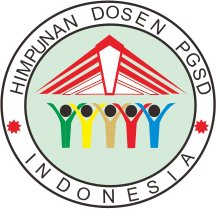How to Improve the Performance of Public Elementary Schools? an Empirical Evidence from Indonesia
Downloads
Downloads
Abraham, M., Kaliannan, M., Mohan, A. V., & Thomas, S. (2015). A review of SMEs recruitment and selection dilemma: Finding a "fit." The Journal of Developing Areas, 49(5), 335–342. https://doi.org/10.1353/jda.2015.0058
Alharthy, A. A. H., & Marni, N. Bin. (2020). Training impact on the human resources performance. Journal of Southwest Jiaotong University, 55(3), 1–6. https://doi.org/10.35741/issn.0258-2724.55.3.12
Andriani, D. E., Dania, R., Suyud, S., Raharja, S., & Kristyningsih, D. M. (2022). The profile of principals' instructional leadership in primary schools with high, moderate, and low achievement. Jurnal Prima Edukasia, 10(2), 159–170. https://doi.org/10.21831/jpe.v10i2.48302
Anggita, N., & Asrida, W. (2014). The efforts of the Pekanbaru city education office in increasing the accreditation value of elementary schools in the city of Pekanbaru in 2012. Jurnal Online Mahasiswa (JOM) Bidang Ilmu Sosial dan Ilmu Politik, 1(1), 1–14. https://jom.unri.ac.id/index.php/JOMFSIP/article/view/2182
BellibaÅŸ, M. Åž., Gí¼mí¼ÅŸ, S., & Kılıní§, A. í‡. (2020). Principals supporting teacher leadership: The effects of learning-centered leadership on teacher leadership practices with the mediating role of teacher agency. European Journal of Education, 55(2), 200–216. https://doi.org/10.1111/ejed.12387
Bernal, P., Mittag, N., & Qureshi, J. A. (2016). Estimating effects of school quality using multiple proxies. Labour Economics, 39, 1–10. https://doi.org/10.1016/j.labeco.2016.01.005
Bernardin, H. J., & Russel, J. E. A. (2003). Human Resources Management. Mc Graw-Hill.
Blazar, D., & Kraft, M. A. (2017). Teacher and teaching effects on students' attitudes and behaviors. Educational Evaluation and Policy Analysis, 39(1), 146–170. https://doi.org/10.3102/0162373716670260
Bonney, E. A., Amoah, D. F., Micah, S. A., Ahiamenyo, C., & Lemaire, M. B. (2015). The relationship between the quality of teachers and pupils academic performance in the STMA junior high schools of the western region of Ghana. Journal of Education and Practice, 6(24), 139-150. https://doi.org/10.7176/JEP
Bramley, G. (1995). School performance indicators and school effectiveness: the conceptions and the critiques. University of Wolverhampton.
Carter, E., Onwuegbuzie, A., Singal, N., & van der Velde, L. (2021). Perceptions of teaching quality in Rwandan secondary schools: A contextual analysis. International Journal of Educational Research, 109. https://doi.org/10.1016/j.ijer.2021.101843
Cuyvers, K., De Weerd, G., Dupont, S., Mols, S., & Nuytten, C. (2011). Well-being at school: Does infrastructure matter? CELE Exchange, 2011(10), 1–6.https://doi.org/10.1787/5kg0lkzc81vc-en
Donaldson, L., & Davis, J. H. (1991). Stewardship theory or agency theory: CEO governance and shareholder returns. Australian Journal of Management, 16(1), 49–64. https://doi.org/10.1177/031289629101600103
Faisal, & Martin, S. N. (2019). Science education in Indonesia: Past, present, and future. Asia-Pacific Science Education, 5(1), 1–29. https://doi.org/10.1186/s41029-019-0032-0
Flink, C., & Molina, A. L. (2021). Improving the performance of public organizations: Financial resources and the conditioning effect of clientele context. Public Administration, 99(2), 387–404. https://doi.org/10.1111/padm.12690
Garengo, P., Sardi, A., & Nudurupati, S. S. (2021). Human resource management (HRM) in the performance measurement and management (PMM) domain: A bibliometric review. International Journal of Productivity and Performance Management. https://doi.org/10.1108/IJPPM-04-2020-0177
Girvan, C., Conneely, C., & Tangney, B. (2016). Extending experiential learning in teacher professional development. Teaching and Teacher Education, 58, 129–139. https://doi.org/10.1016/j.tate.2016.04.009
Gosal, R. (2018). Public perception of facilities and infrastructure quality at school as one facilities on Sindue district, Donggala regency. Asian Journal of Environment, History and Heritage, 2(2), 217–222. https://spaj.ukm.my/ajehh/index.php/ajehh/article/view/88
Government Regulation of the Republic of Indonesia Number 13 of 2015. (2015). Jakarta.
Government Regulation of the Republic of Indonesia Number 4 of 2022. (2022). Jakarta.
Government Regulation of the Republic of Indonesia Number 57 of 2021. (2021). Jakarta.
Graham, L. J., White, S. L. J., Cologon, K., & Pianta, R. C. (2020). Do teachers' years of experience make a difference in the quality of teaching? Teaching and Teacher Education, 96, 1–10. https://doi.org/10.1016/j.tate.2020.103190
Granado, J. A. del, Fengler, W., Ragatz, A., & Yavuz, E. (2007). Investing in Indonesia's education: Allocation, equity, and efficiency of public expenditures. Munich Personal RePEc Archive, 4372, 1–43. https://doi.org/10.5897/JAERD12.088
Hagood, L. P. (2019). The financial benefits and burdens of performance funding in higher education. Educational Evaluation and Policy Analysis, 41(2), 189–213. https://doi.org/10.3102/0162373719837318
Hasbullah, A., Zahari, W., Yusoff, W., Maziah, I., & Prima, V. (2011). A framework study of school facilities performance in public primary school of Batubara district in Indonesia. Procedia Social and Behavioral Sciences, 15, 3708–3712. https://doi.org/10.1016/j.sbspro.2011.04.360
Hermanto, H. (2022). The teacher performance evaluation in learning management in inclusive settings. Jurnal Prima Edukasia, 10(1), 28–36. https://doi.org/10.21831/jpe.v10i1.37511
Hermanto, H., & Pamungkas, B. (2023). School and parents collaboration in home learning service for students with sensory impairments. Jurnal Prima Edukasia, 11(1), 9–15. https://doi.org/http://dx.doi.org/10.21831/jpe.v11i1.51614
Hilton, A., Hilton, G., Dole, S., & Goos, M. (2015). School leaders as participants in teachers' professional development: The impact on teachers' and school leaders' professional growth. Australian Journal of Teacher Education, 40(12), 103–125. https://doi.org/10.14221/ajte.2015v40n12.8
Hong, K., & Zimmer, R. (2016). Does investing in school capital infrastructure improve student achievement? Economics of Education Review, 53, 143–158. https://doi.org/https://doi.org/10.1016/j.econedurev.2016.05.007
Howie, E. K., & Pate, R. R. (2012). Physical activity and academic achievement in children: A historical perspective. Journal of Sport and Health Science, 1(3), 160–169. https://doi.org/10.1016/j.jshs.2012.09.003
Hoy, W. K., & Miskel, C. G. (2001). Educational Administration: Theory, research and practice, 8th edition. McGraw-Hill.
Iqbal, Y., & Wardana, A. (2019). Social capital and school principal roles in improving school quality of Muhammadiyah 3 Yogyakarta high school. Advances in Social Science, Education and Humanities Research (ASSEHR), 330, 281–285. https://doi.org/10.2991/iceri-18.2019.59
Jacobsen, R., Snyder, J. W., & Saultz, A. (2015). Understanding satisfaction with schools: The role of expectations. Journal of Public Administration Research and Theory, 25(3), 831–848. https://doi.org/10.1093/jopart/muu026
Kharisma, B., Remi, S. S., & Maharani, D. A. (2021). The impact of Indonesia's school operational assistance program on the transition rate from primary to junior secondary school. The Monitoring of Public Opinion Economic & Social Changes, 5, 474–492. https://doi.org/10.14515/MONITORING.2021.5.1787
Klassen, R., & Kim, L. (2019). Selecting teachers and prospective teachers: A meta-analysis. Educational Research Review, 26, 32–51. https://doi.org/10.1016/j.edurev.2018.12.003
Kubat, U. (2018). Identifying the individual differences among students during learning and teaching process by science teachers. International Journal of Research in Education and Science, 4(1), 30–38. https://doi.org/10.21890/ijres.369746
Lamas, H. E. (2015). School performance. Propósitos Y Representaciones, 3(1), 313–386. http://dx.doi.org/10.20511/pyr2015.v3n1.74
Mbore, C., & Cheruiyot, T. (2017). Employee performance measurement and management in the African public sector. International Journal of Science: Basic and Applied Research (IJSBAR), 36(1), 187–201. https://gssrr.org/index.php/JournalOfBasicAndApplied/article/view/7964
Muda, I., & Rafiki, A. (2014). Human resources development and performance of government provincial employees: A study in north Sumatera, Indonesia. Journal of Economics and Behavioral Studies, 6(2), 152–162. https://doi.org/10.22610/jebs.v6i2.478
Munna, A. S., & Kalam, M. A. (2021). Teaching and learning process to enhance teaching effectiveness: A literature review. International Journal of Humanities and Innovation (IJHI), 4(1), 1–4.
Niemi, H. (2015). Teacher professional development in Finland: Towards a more holistic approach. Psychology, Society, and Education, 7(3), 279–294. https://doi.org/10.25115/psye.v7i3.519
Noviana, I. (2018). The relationship between the parents' parenting activities and the habit of watching educational programs with the moral values. Jurnal Prima Edukasia, 6(2), 136–146. https://doi.org/10.21831/jpe.v6i2.9742
Razinkina, E., Kalinina, O., & Zima, E. (2021). The system of professional development and assessment of the competencies of university teaching staff to ensure quality education in the interests of sustainable development of society: A case study of Russia. E3S Web of Conferences, 296, 1–7. https://doi.org/10.1051/e3sconf/202129608011
Sakamoto, J. (2022). Financing public schools with private funds: Efficiency–equity trade-off of multi-stakeholder school financing in Punjab, Pakistan. Education Policy Analysis Archives, 30(75), 1–31. https://doi.org/10.14507/epaa.30.6828
Setia, R., & Nasrudin, D. (2020). School management: The optimization of learning facilities to improve the quality of vocational schools. Jurnal Pendidikan Vokasi, 10(2). https://doi.org/10.21831/jpv.v10i2.29981
Setyaningsih, C. D. (2017). Accreditation status and school quality in public elementary schools. Jurnal Manajemen dan Supervisi Pendidikan, 1(2), 138–145. https://doi.org/10.17977/um025v1i22017p138
Siddiqui, N., & Gorard, S. (2017). Comparing government and private schools in Pakistan: The way forward for universal education. International Journal of Educational Research, 82, 159–169. https://doi.org/10.1016/j.ijer.2017.01.007
Sulthon, M., Pujiastuti, P., & Retnawati, H. (2021). What is the teacher's challenge on the developing of learning media to increase critical thinking ability and the character? Jurnal Prima Edukasia, 9(1). https://doi.org/10.21831/jpe.v9i1.34876
Valdés, M. T. (2022). Unequal expectations? Testing decisional mechanisms for secondary effects of social origin. Social Science Research, 105, 1–17. https://doi.org/10.1016/j.ssresearch.2021.102688
Wahjusaputri, S., Syarif, S., Handayani, S. P., Ernawati, E., & Nastiti, T. I. (2023). Continuous professional development of teachers through teaching clinics at muhammadiyah 28 islamic elementary school. Jurnal Prima Edukasia, 11(1), 30–37. https://doi.org/http://dx.doi.org/10.21831/jpe.v11i1.52470
Yangambi, M. (2023). Impact of school infrastructures on students learning and performance: A case of three public schools in a developing country. Creative Education, 14(4), 788–809. https://doi.org/https://doi.org/10.4236/ce.2023.144052
Yanova, N. (2015). Assessment of satisfaction with the quality of education: Customer satisfaction index. Procedia - Social and Behavioral Sciences, 182, 566–573. https://doi.org/10.1016/j.sbspro.2015.04.782
The copyright of the received article shall be assigned to the journal as the publisher of the journal. The intended copyright includes the right to publish the article in various forms (including reprints). The journal maintains the publishing rights to the published articles.

Jurnal Prima Edukasia by http://journal.uny.ac.id/index.php/jpe/index is licensed under a Creative Commons Attribution-ShareAlike 4.0 International License.


























